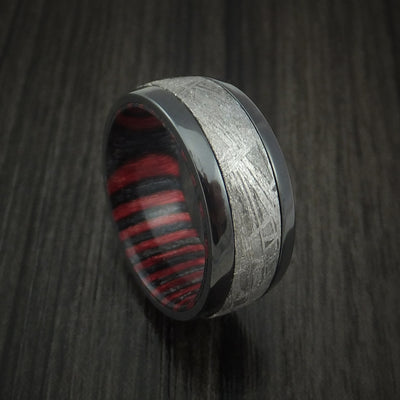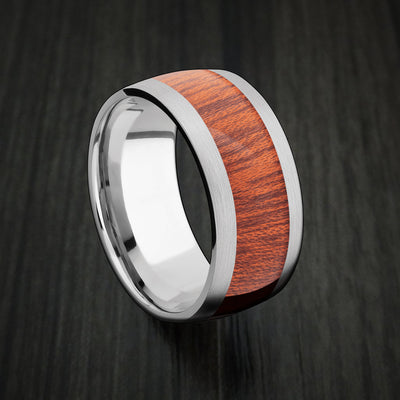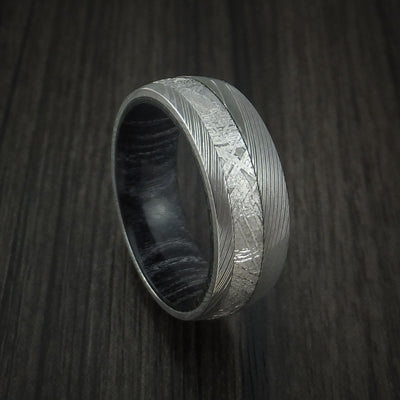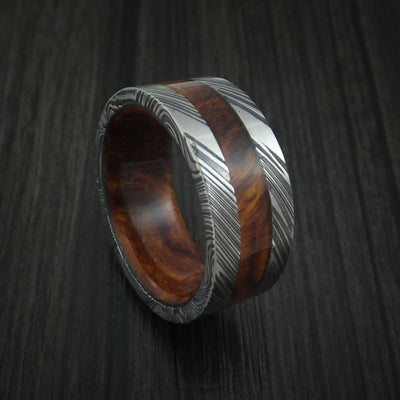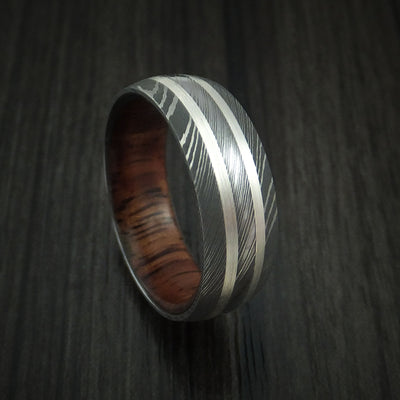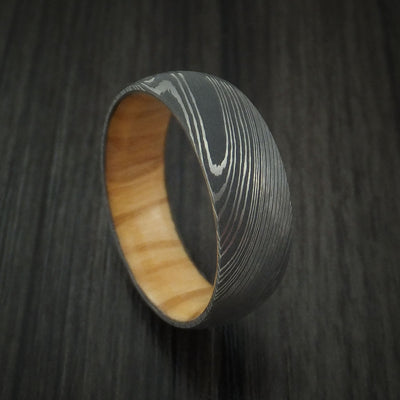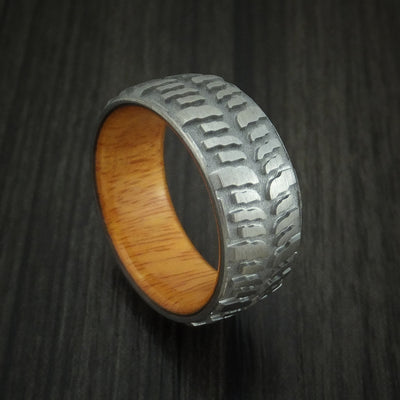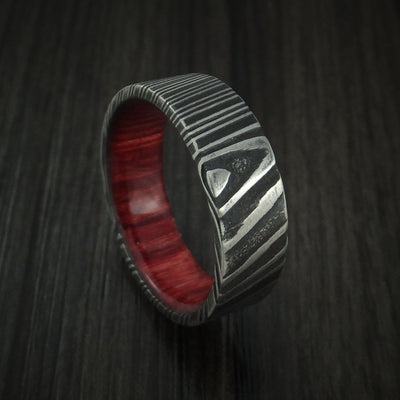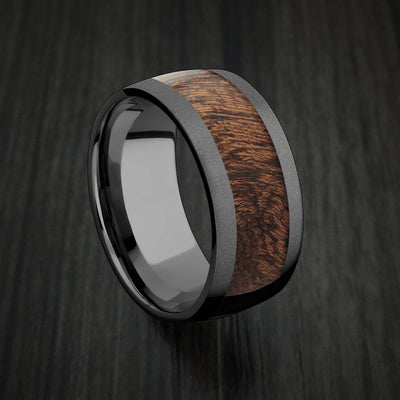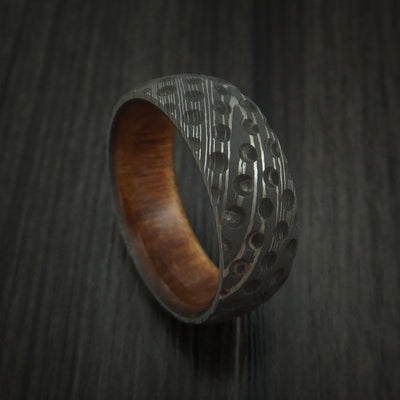Our Exotic Hardwood rings are made with the finest hardwood available. Hardwood rings are a beautiful combination of natural cut hardwood and custom formed alternative metal. You can’t go wrong with an Exotic Hardwood ring from Revolution Jewelry.
View our Exotic Hardwood Collection
To view additional examples of a specific type of hardwood click on the image of the hardwood.
*Woods marked with an asterisk are colored and/or laminated wood types, consisting of Birch or Oak. The name of the wood type refers to the color of stain used, and not the species of wood.
Bocote
Bocote is native to Mexico. It can have a wide range of patterns with outstanding, zebra-like contrasts of nearly black strips. The color varies from golden brown to tan to a golden yellow color. It is a hardy, heavy wood.
Desert Ironwood Burl
Desert Ironwood is a rare tree that grows in the Sonoran Desert in the USA and Mexico. This wood has an appealing grain pattern, with good contrast and figuring. It is also very hard and dense to the point that it actually sinks in water.
Jack Daniel's Barrel Wood
Jack Daniel's Barrel wood comes from the whiskey barrels that Jack Daniel's uses to age and mature their whiskey. The barrels are handmade using American White Oak wood. The barrels are only used once before they are sold for a variety of purposes, including being used in our rings.
Koa Wood
Koa wood comes from a flowering tree on the Hawaiian islands. It has a good variety of color, but it is normally a medium brown to a red brown color and generally has contrasting dark streaks. Traditionally it was used to make canoes and surfboards, but it is also used to make instruments such as ukuleles and guitars.
Leopard Wood
Leopard wood is a very dense and hard wood that comes from Central and South America. It has a unique spotted pattern, resembling the marks on a leopard. The color varies brown to a red-brown with spots of light brown to grey.
Maple Burl
Maple Burl comes from the USA. It is a rare growth on a common tree. It varies from a honey brown to a medium brown color. This rare growth features an unusual pattern of tight swirls in the grain. Once it is polished, the wood has a slight sheen to it.
Olive Wood
Olive wood is native to Europe, Africa, and the Middle East. It has a tan color with black, gray, and brown streaks. Overtime it becomes darker and more attractive in color. Olive wood has traditionally had sentimental and religious significance to several cultures and religions.
Osage Orange Wood
Osage Orange originated in Argentina, but in the 1930's it was planted in the plain states of the USA. It is a dense, very hard wood with a yellow-orange color.
Padauk Wood
Padauk wood comes from Africa and was historically used as an herbal medicine for treating infections. The color varies from a bright orange to a deep, orange-red. Overtime Paduak wood will fade to a warm slightly red-brown color.
Purple Heart
Purple Heart is a hard, heavy wood from Central and South America. It has a unique purple color with grains that vary from straight to wavy to interlocking. Overtime it can darken to a darker brown color with a hint of purple.
Red Heart
Red Heart comes from Honduras and is a bright red hardwood with variations of a lighter pink-red to a darker brown-red. Overtime, the wood will fade to a darker, more reddish-brown color.
Snakewood
Snakewood is an extremely dense wood from South America that can be challenging to work with. However, its unique pattern makes it worth the effort. It is a reddish-brown color with irregular black markings making it truly one of a kind.
Spalted Tamarind
Spalted Tamarind is a pale-yellow wood that has black streaks throughout the veins. It comes from the Tamarind tree in Africa which is known for its fruit that produces a sweet/sour flavored pod.
Teak
Teak wood is native to Southern Asia, but it is also grown in tropical regions of Africa, Asia, and Latin America. It ranges in color from golden to medium brown with a slightly darker grain that is generally straight, but can occasionally be wavy. As the wood ages the color can darken up.
Thuya Burl
Thuya Burl ranges in color from orange to red-brown. It normally includes many tightly arranged 'eyes'. They Burl comes from Morocco, Algeria, Tunisia, and Spain from knot clusters on the roots of the Thuya tree. The Thuya tree is a small tree that has the unique ability to regrow itself from a stump allowing it to regenerate after a wildfire.
Walnut
Walnut is native to Southwest Asia, but is now commonly grown across the USA, England, and other countries. Walnut wood is generally straight, but can be irregular. Its colors vary from a light pale brown to a dark chocolate brown with dark brown streaks.
Wenge Wood
Wenge Wood comes from Africa and is a dark brown wood that has unique black streaks in the grain. Its distinct dark coloring, pattern, and hardness make it ideal for furniture and musical instruments including high-end drums.
Zebrawood
Zebrawood is a hardwood native to Western Africa. It gets its Zebra-like appearance from the light brown colored sapwood paired with the contrasting dark brown/black colored grain.
Ziricote
Ziricote is native to Belize, Guatemala, and Mexico. It is a hard, dense wood with colors ranging from reddish brown to dark brown with distinct black streaks. Due to its attractive coloring, it is commonly used to make knife handles and furniture.



